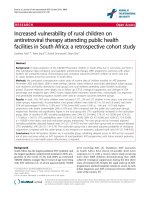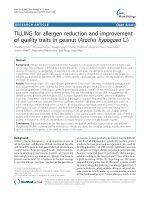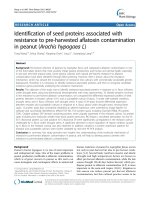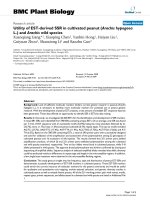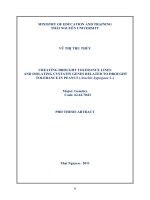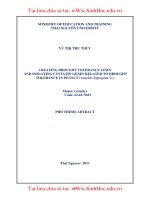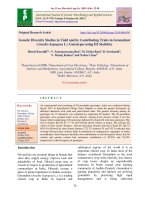Isolation of aspergillus parasiticus and detection of aflatoxin B1 on local peanut (Arachis hypogaea L.) varieties in Bali
Bạn đang xem bản rút gọn của tài liệu. Xem và tải ngay bản đầy đủ của tài liệu tại đây (239.22 KB, 9 trang )
Int.J.Curr.Microbiol.App.Sci (2018) 7(8): 4636-4644
International Journal of Current Microbiology and Applied Sciences
ISSN: 2319-7706 Volume 7 Number 08 (2018)
Journal homepage:
Original Research Article
/>
Isolation of Aspergillus parasiticus and Detection of Aflatoxin B1 on Local
Peanut (Arachis hypogaea L.) Varieties in Bali
A.S. Duniaji*, W. Putu Arisandhi, N.N. Puspawati and C.D. Ni Putu Novilia
Department of Food Science and Technology University of Udayana Bali, Indonesia
*Corresponding author
ABSTRACT
Keywords
Local peanuts, A.
parasiticus,
Aflatoxin B1
Article Info
Accepted:
26 July 2018
Available Online:
10 August 2018
This study was aimed to determine the contamination of Aspergillus parasiticus and
aflatoxin B1 on Local varieties of peanuts in Bali. A total of 18 Local varieties of peanut
were taken at several farmers in the field on each district in Bali. This study used
descriptive analysis that showed in the form of figure and table. Samples were isolated
using PDA (Potato Dextro Agar) during the incubation period 5 days (120 hours) at room
temperature (29 °C) and further purified by the media DRBC (Dichloran Rose Bengal
Chlorampenicol) and Aflatoxin B1 was analyzed using the Enzyme Linked
Immunosorbent Assay (ELISA) [Chinaphuti, 2003]. The results showed A. parasiticus
contaminated Local varieties of peanuts are the lowest in Bali on the sample Amlapura
Local 1, Gianyar Local 1, Mangupura Local 1 and Tabanan Local 1 were 1.0 x 104 cfu
ml-1, and the highest population present in the sample Singaraja Local 1 was 1.0 x 10 5 cfu
ml-1. Aflatoksin B1 content of the peanut contaminating Local varieties ranged from 2.4 ±
0.57 ppb – 100 ppb. Local varieties of peanuts for consumption according to Codex
standards maximal 15 ppb is 94.4 % (ranged from 0-15 ppb)
In the early 1960s, many laboratories focused
their attention on an outbreak of hepatotoxic
disease in turkeys and other poultry (turkey X
disease), a problem affecting animals
worldwide (Anonymous, 2004).
(Cullen and Newberne, 1994), contaminating
a number of agricultural products such as
peanuts, corn, and cereal grains (Dharmaputra,
1999). Aflatoxin contamination occurs by
colonization of the fungus on susceptible
crops, or may arise during harvesting, drying,
storage, or processing.
Turkey X disease was attributed to
contamination of peanut meal with aflatoxins,
toxic metabolites produced by some strains of
Aspergillus flavus, A. parasiticus, and A.
nomius (Boutrip, 1977; Chinaphuti, 2003).
Strains of A. flavus and A. parasiticus can
produce aflatoxins B1, B2, G1, G2 and M
Peanut is a legume commodity product in
Indonesia, which are mostly used for the
purpose of consumption. The production of
peanuts in Bali reached 11.582 tons (1). The
figure shows the highest production compared
to soy production reached 5.555 tons and a
total of 753 tons of green beans.
Introduction
4636
Int.J.Curr.Microbiol.App.Sci (2018) 7(8): 4636-4644
The top position peanuts as a source of cash
income for farmers in Indonesia (Kasno,
2005). However, the presence of impurities of
boletus in peanuts cause losses not least,
because the percentage of boletus are infecting
peanut in Indonesia is quite high. The main
species that contaminate peanut A. flavus and
A. parasiticus (Pitt et al., 1998), with the
resulting toxin called aflatoxin.
Crops contaminate most nuts and is a major
problem in the world. In Australia the major
crops has been a problem in the peanut
industry since 20 years ago, but has now
become a major issue for the industry food
safety (Johnson, 1997). Aflatoxin poisoning
does not lead to acute, but in chronic liver
organ disorders cause. However until now in
Indonesia such issues have not been a serious
attention from various parties, to control
aflatoxin contamination problems and resolve
them.
The presence of contamination of boletus in
peanuts cause high economic losses among
other
occur
automatic
detention
(imprisonment)
against
Indonesia
in
agricultural commodities in the world market,
the loss of agricultural products that are quite
high
(cannot
be
consumed/sold)
(Kozakiewics, 1995).
Aflatoxin contamination in peanut seed is an
important issue to the quality of food around
the world. The percentage of samples
contaminated peanut aflatoxin and aflatoxin
total deposits increased from 35% to 55%,
from range 19.4-39.8 ppb become 10.1- 88.5
ppb. Two types of aflatoxin are found which
are B1 and B2, which types of crops which are
most frequently found is B1.
Based on the research done the isolation of A.
parasiticus and the detection of aflatoxin B1
of local peanuts (Arachis hypogeae L.)
varieties in Bali.
Materials and Methods
Sample preparation
The materials used in the study include peanut
varieties obtained from local farmers in Bali,
media Potato dextrose agar (PDA), media
DRBC
(Dichloran
Rose
Bengal
Chlorampenicol) consisting of 10 g of
glucose, 5 g of peptone, 1 g of KH2PO4,
0.05gram MgSO47H2O, 0.05g rose Bengal,
0.01 g of chloramphenicol, 0.2 dichloran in
ethanol 1 ml of sterile water, pH 5.6 (King et
al., 1979), Whattman No 2, methanol, alcohol
96%, Test Kit of aflatoxin B1 (Chinaphuti,
2003).
This research carried out in the laboratory of
Microbiology
Laboratory,
Faculty
of
agricultural technology, Laboratory of
Veterinary of Province of Bali. Sampling was
done randomly at centre of peanut production,
where each sample specified taken to more
farmers. A total of 18 Local varieties of
peanut were taken at several farmers in the
field on each district in Bali. 500-1000 g of
sample of peanut was taken ranges between of
material chosen at random. This research used
descriptive analysis that showed in the form of
figure and table. The description of the 18
samples were obtained from each Center for
agriculture in the 9 districts in Bali can be
seen in table 1.
Isolation and identification
A. parasiticus was isolated from 18 samples of
peanut Varieties in 9 Local district in Bali.
Peanuts are cleaned first with water, then
crushed with a sterile blender. 10 g of the
sample taken and entered into 90 ml of sterile
water in an Erlenmeyer flask. Then as much as
1 ml inoculated in the Petri dish was filled
with media PDA. Cultures incubated in room
temperature for 5 days (120 hours), therefore
was done identification.
4637
Int.J.Curr.Microbiol.App.Sci (2018) 7(8): 4636-4644
The isolates A. parasiticus was isolated using
cork borer to be inoculated in DRBC medium
and then stored for 5 days (120 hours) in room
temperature. Identification is done by
observing isolates A. parasiticus in
microscope
B
% absorbnsi = ------- x 100
B0
Description
B: the value of absorbance of each sample
B0 standard: the value of absorbance in 0
Detection of Aflatoxin B1
20 g of samples weighed and put into blender
add 100 ml of methanol 70 on a sample, then
the most high speed blender for 2-3 minutes.
After samples destroyed filtered using filter
paper Whatman No. 4 and strain samples to
extract a clear look. The filtrate is
accommodated as many as 1.0 ml with
microtubule and and added 1 ml of sterile
water.
A Total of aflatoxin contained in each sample
can be calculated using paper millimeters.
Where X is a line of standard aflatoxin B1
concentration while the maximum absorbance
indicates each Y sample (Chinaphuti, 2003).
A standard solution of aflatoxin (0; 0.2; 0.5; 1,
2 and 5 (ng/ml)) and a sample of 50 µl put into
the micro wells, incorporated into the
respective wells. Wells that already contain
standard and sample each added enzyme
conjugate to each well 50 µl and wells
incubated for 30 min at room temperature and
dark spaces. The liquid in the micro wells
subsequently disposed outside on tissue paper
clean and washed with sterile water. The work
was repeated four times.
The research was conducted on 18 samples of
local peanut varieties obtained from each
distric in Bali. Isolation of A. parasiticus using
media DRBC (Dichloran Rose Bengal
Chlorampenicol) and medium PDA (potato
dextro to) local varieties of peanuts during the
incubation period of 5 days can be seen in
Figure 1.
A substrate contains 3.3 ' 5, 5 'Tetramethylbenzidine 0.4 g/l in alkaline
organic and substrate B contains 0.02 H2O2 in
citric acid buffer. Substrates A and B mixed
30 minutes earlier. Later added as much as
100 µl into wells is blended well and
incubated for 5 minutes at room temperature
and dark spaces.
The solution contains 0.01 M stop reaction of
phosphate acid as much as 100 µl added into
respective wells. Further reading absorbance
on the activities of the micro wells by ELISA
Reader at a wavelength of 450 nm. OW to
calculate number of aflatoxin in peanuts is
Results and Discussion
Characteristic of A. parasiticus
Figure 1 can be seen A. parasiticus color
green darkness colonies commonly called ivy
green in colour (King et al., 1979). A.
parasiticus can germinate on surface wounds
from crops (corn and beans). Then penetrate
against the growth of the embryo.
Observations with the microscope showed
morphological forms of A. parasiticus as in
Figure 2.
Description:
A = mold Aspergillus parasiticus: stigmata
B = vesicles of the mold Aspergillus
parasiticus
C = mold Aspergillus parasiticus konidia
4638
Int.J.Curr.Microbiol.App.Sci (2018) 7(8): 4636-4644
D = konidiofor mold Aspergillus parasiticus
According to (Pitt and Hocking, 1997), A.
parasiticus has conidiophore that emerges
from the surface of the Harare International
Festival of the -500 length 250 µm, colorless
or light brown and smooth-walled; spherical
vesicles with diameter 20 µm and -35 only 3/4
of the surface of the vesicles in the fertile
(fertile); vesicles form the phialide-11 µm
long, 7 conidia producing spherical, usually 46 µm in diameter, rough-shaped cell walls and
usually forms the head of the conidia of the
round (King et al., 1979; Pitt and Hocking,
1997). A. parasiticus is growing at between
12-40 ° C with an optimum growth
temperature of 30 ° C; the value of aw
minimum for growth was 0.82 at a
temperature of 25 ° C, 0.81 at a temperature
30 ° C and at a temperature of 37 ° 0.80 C and
pH between 1.5-10.5 on the temperature of the
third (Pitt and Hocking, 1997).
Population of A. parasiticus
Research results of the 18 samples of local
peanut varieties obtained from local farmers in
each district in Bali, showed a variation of A.
parasiticus on local varieties of peanuts. In
Table 3 can be seen the population of A.
parasiticus, which contaminate local peanut
varieties.
The Table 3 can be seen that the population of
A. parasiticus, which contaminate local peanut
varieties was vary. The smallest population is
10 x 103 cfu.ml-1 - 10.2 × 104 cfu.ml -1. The
population of A. parasiticus is lowest in
samples of AL1, GL1, ML1 and TL1 was 10 x
103 cfu.ml-1. While the highest populations
are present in a sample of SL2 are 10.2 x 104
cfu.ml-1. This is caused by A. parasiticus
growth ability on optimum temperature 32 ° C
growth; the value of the minimum for the
growth is the aw 0.82 at a temperature of 25 °
C; 0.81 at a temperature of 30 ° C and at a
temperature of 37 ° 0.80 C and pH between
1.5-10.5 on the temperature of the third (King
et al., 1979; Pitt and Hocking, 1997).
According to (King et al., 1979; Kuswantoro
and Sudarmadji, 1988). Since in the soil,
during drying and storage can be covered by
the mold A. parasiticus and A. flavus. Suitable
Habitat for the growth of the mold is the
moisture content of 14-30 and a temperature
between 21-37°C. In the closed storage and
aeration conditions less encourage mold
growth.
Aflatoksin B1 content of peanut
Results of the analysis of the content of
aflatoxin B1 on the 18 samples of local peanut
varieties taken of farmers in each district in
Bali can be seen in Table 4.
In the Table 4 can be seen that there are
variations in contamination AFB1 of local
peanut varieties. Contamination AFB1 in local
peanut varieties ranges from 1.5 – 14 ppb ppb,
while samples of the DL2 in excess of 100
ppb
Variation of aflatoxin content in peanuts can
be caused by several factors, namely crops can
be produced by A. parasiticus at between 1240 ° C, the water activity (Aw) 0.86 and pH 38 (13). According to (Jay, 2000), formation of
aflatoxin pad peanuts occurred at optimum
0.93-0.98 aw and RH 83% or higher at a
temperature of 30 ° c. the ability of mold to
form and store crops depends on several
factors including genetic potential mold
requirements-environmental
requirements
(substrate, temperature, humidity, and pH) and
duration of contact between the mould and the
substrate.
Aflatoxin production is strongly influenced by
the presence of mold, interaction between the
substrate and the environmental conditions
(Saad, 2001; Duniaji, 2009).
4639
Int.J.Curr.Microbiol.App.Sci (2018) 7(8): 4636-4644
Table.1 Providing the code in samples obtained from each district in Bali
Sample
SL1
AL1
KL1
GL1
BL1
DL1
ML1
TL1
NL1
Sample
SL2
AL2
KL2
GL2
BL2
DL2
ML2
TL2
NL2
Sample at Distric of Bali
Farmer at Singaraja 1
Farmer at Amlapura 1
Farmer at Klungkung 1
Farmer at Gianyar 1
Farmer at Bangli 1
Farmersat Denpasar 1
Farmersat Mangunpura 1
Farmer at Tabanan 1
Farmer at Negara 1
Sample at Distric of Bali
Farmer at Singaraja 2
Farmer at Amlapura 2
Farmer at Klungkung 2
Farmer at Gianyar 2
Farmer at Bangli 2
Farmer at Denpasar 2
Farmer at Mangunpura 2
Farmer at Tabanan 2
Farmer at Negara 2
Table.2 Population of A. parasiticus that contaminated local peanuts varieties in Bali (cfu.ml-1)
Sample
SL1
AL1
KL1
GL1
BL1
DL1
ML1
TL1
NL1
A. parasiticus
(cfu.ml-1)
50 x 103
10 x 103
25 x 102
10 x 103
50 x 103
10 x 103
10 x 103
90 x 103
Other fungi
Sampel
84 x 102
20 x 103
95 x 102
90 x 103
28 x 102
30 x 103
10 x 103
40 x 103
30 x 103
SL2
AL2
KL2
GL2
BL2
DL2
ML2
TL2
NL2
A. parasiticus
(cfu.ml-1)
10,2 x 104
20 x 103
20 x 103
10 x 102
20 x 103
40 x 103
40 x 103
12 x 102
Other fungi
58 x 102
40 x 103
20 x 102
90 x 103
37 x 102
90 x 103
17 x 102
90 x 103
40 x 103
Table.3 Aflatoxin B1 content in peanut of local varieties in Bali
Sample
SL1
AL1
KL1
GL1
BL1
DL1
ML1
TL1
NL1
Aflatoxin B1 (ppb)
10.4 ± 0.14
10.8 ± 0.28
8.2 ± 0.28
8.0 ± 0.28
9.2 ± 0.57
4.0 ± 0.28
8.4 ± 0.28
3.6 ± 0.28
8.0 ± 0.57
Sample
SL2
AL2
KL2
GL2
BL2
DL2
ML2
TL2
NL2
4640
Aflatoxin B1 (ppb)
4.8 ± 0.57
8.4 ± 0.28
4.8 ± 0.28
7.4 ± 0.57
6.6 ± 0.28
100
14.0 ± 0.28
5.6 ± 0.28
2.4 ± 0.57
Int.J.Curr.Microbiol.App.Sci (2018) 7(8): 4636-4644
Table.4 The proportion of AFB1 on local varieties of peanut
Content of AFB1(ppb)
0-5
5-10
10-15
100
Proportion (%)
27,78
44,44
22,22
5,56
Fig.1 A. parasiticus in media the DRBC incubated for 5 days (120 hours) at room temperature
Fig.2 A. parasiticus is observed with a microscope with a magnification of 400x
Fig.3 Test results ELISA AFB1 in ground nuts local varieties
Aflatoxin is produced by A. flavus and A.
parasiticus on groceries will be spurred its
creation in the depressed mold condition
(stress), due to the limited nutrition and
environmental temperature is high (Boutrip,
1977; Dharmaputra et al., 2005). A high
concentration of aflatoxin can also occur as a
result of poor post-harvest handling especially
during storage under conditions of high
humidity, which also occurred in field before
harvest (Bankole and Mabekoje, 2004).
According to Kozakiewics (1995), Duniaji
4641
Int.J.Curr.Microbiol.App.Sci (2018) 7(8): 4636-4644
(2009). States the drought (water stress), high
temperature and insect destroyer host plants is
a major factor and the production of aflatoxin
mould infestations.
ELISA test results showed a discoloration of
the substrate on the samples examined.
Yellow color on the test substrate ELISA
shows a lower content of AFB1 compared to
the clear color on the ELISA test. In Figure 3
the ELISA test results can be seen in the
sample the local varieties of peanuts.
Figure 3 indicates that the yellow color is
obtained after using stopping reactions on
substrates before reading absorbance at micro
wells with an ELISA Reader at a wavelength
of 450 nm. The comparison of the color
yellow shows more the low content of AFB1.
Instead the more nodes the higher content of
AFB1.
Requirements/standards of the Codex
alimentary Commission the maximum content
of AFB1 in ground nuts is 15 ppb. Based on it
can be noted that the proportion of local
varieties
of
peanuts
aflatoxin
B1
contaminated in Bali. Can be seen in Table 5.
Sample (DL2) is unfit for consumption due to
the aflatoxins content more than 100 ppb that
is in excess of the standards. According to
(Chinaphuti, 2003; Loosmore and Marksman,
1961; Wilson and Payne, 1994), the standards
of the Codex Alimentary Commission
recommends the content of aflatoxin 15 ppb
(AFB1, AFB2, AFG1, AFG2) on peanuts and
aflatoxin M1 0,05 ppb in the milk. According
to FDA standards established Indonesia since
9 September 2004 namely the content of
aflatoxin B1 and total aflatoxin in peanuts
processed by 20 and 35 ppb (Busby and
Wogan, 1984)
A. parasiticus contaminated local varieties of
peanuts are the lowest in Bali on the sample
Amlapura Local 1, Gianyar Local 1,
Mangupura Local 1 and Tabanan Local 1 was
1.0 x 104 cfu ml-1, and the highest population
present in the sample Singaraja Local 1 is 1.0
x 105 cfu ml-1. Aflatoksin B1 content of the
peanut contaminating local peanut varieties
ranged from 2.4 ppb – 14.0 ppb. Local
varieties of peanuts for consumption
according to Codex standards maximal 15
ppb is 94.4 %.
References
Table 5 can be seen that the proportion of
AFB1 was found 27, 78 percent at 5 samples
(DL1, TL1, SL2, KL2, NL2) range 0-5 ppb. It
was found 44.44 percent of 9 samples (KL1,
GL1, BL1, ML1, NL1, AL2, GL2, BL2, TL2)
Ranging 5-10 ppb and 22.22 percent was
found at 3 sample (SL1, AL1, ML2) range
10-15 ppb., while the range more than 100
ppb sample (DL2) is 5,56 percent and these
samples was not recommended for
consumable. Aflatoxin was found in the
highest sample DL2 which is more than 100
ppb, whereas the lowest aflatoxin content of
the sample NL2 is 4 ppb. While the standard
FDA United States (USFDA) and the Food
Drug Administration (FDA) maximum of
AFB1 Indonesia on peanuts is 20 ppb
Anonymous. 2004. Agricultural Statistics.
The Department Of Agriculture. Jakarta
Anonymous. 2010. Bali in figures. The
Department Of Agriculture. Bali
Asao, T., G. Buchi, M.M. Abdel-Kader, S.B.
Chang, E.L. Wick, G.N. Wogan,
Aflatoxins B and G, J. Am. Chem. Soc.
85 (1963) 1706–1707.
Asplin, F.D., R.B.A. Carnaghan, The toxicity
of certain groundnut meals for poultry
with special reference to their effect on
ducklings and chickens, Vet. Rec. 73
(1961) 1215–1219.
Bankole, S.A. and Mabekoje, O.O. 2004.
Occurring of aflatoxins and Fumonisins
in Preharvest Maize from South-western
4642
Int.J.Curr.Microbiol.App.Sci (2018) 7(8): 4636-4644
Nigeria.
Food
additive
and
Contaminants, 21, 251-255.
Boutrip, E. 1977. Prevention of Mycotoxin in
Pitachios. Division Food quality and
Standards Service. FAO Food and
Nutrition, Pitachios ’97 Conference,
Rome, Italy. Pp 1-12.
Busby, W.F., and G.N. Wogan, Aflatoxin, in:
C.E.
Searle
(Ed.),
Chemical
Carcinogens,
American
Chemical
Society, Washington, DC, 1984, pp.
945–1136.
Chinaphuti, A. 2003. Aflatoxins in Peanuts
and Peanuts Product. Workshop on
Handling and Measurement of the
Quality of Peanut and Peanut Products
Held by Katsersart University, CRSP
and USAID in Bangkok Thailand
(2003)
Cullen, J.M., and P.M. Newberne, Acute
hepatotoxicity of aflatoxins, in: D.L.
Eaton, J.D. Groopman (Eds.), The
Toxicology of Aflatoxins; Human
Health, Veterinary, and Agricultural
Significance, Academic Press, San
Diego, CA, 1994, pp. 3–26.
Dharmaputra OS, Putri ASR, Retnowati I,
Ambarwati S. 2005. Soil mycobiota of
peanut fields in Wonogiri regency,
Central Java: Their effect on the growth
and aflatoxin production of Aspergillus
flavus in vilro. Biolropia 17:30-58.
Dharmaputra OS. 1999. Review on fungi and
mycotoxins in Indonesian commodities.
Di dalam: Jin ZX, Liang Q, Liang YS,
Tan XC, Guan LH (ed). Stored Product
Proleclion. Proceedings of the 7'h
international Working Conference on
Stored-Product Protection; Beijing, 1419 Okt 1998. Chengdu: Sichuan
Publishing House of Science &
Technology. lhlm 199-216.
Duniaji, A.S. 2009. Detection of aflatoxin B1Induced Cancer in several fried peanut
products. “3rd International Workshop
on Food Functional Clinical Research”
19 Sept 2009
Jay. JM. 2000. Modern Food Microbiology.
Fourth Edition. Chapman and Maggon,
KK;
SK
Gupta
and
TA.
Venkitasubramanian.
1997.
Biosynthesis
of
Aflatoxin.
Bacteriological Review p 822-855.
Department
of
Biochemistry,
Vallabhbhai, Vatel hes Institute,
University of Delhi India
Johnson, G. 1997. Reducing Aflatoksin in
Peanut Using Agronomic Management
and Biocontrol Strategies in Indonesia
and Australia. Australian Centre for
International Agricultural Research
Kasno, A. 2005, profiles and Peanut
Production technique of Perkernbangan
in
Indonesia.
Regular
Seminar
Acehnese remain vulnerable food
plants: May 26, 2005. Bogor
King, A.D., A.D. Hocking and J.L. Pitt. 1979.
Dichloran Rose engal Chlorampenicol
Medium for Enumeration and Isolation
of
Mold
from
Food.
Appl.Environ.Microbial. 37: 959-964.
Kozakiewics,
Z.
1995.
Mycotoxin
Contamination in Grain: Occurrence
and Significance of Storage Fungi
Associated Mycotoxins in Rice and
Cereal Grain. ACIAR. Australia. 18 19.
Kuswantoro, K. and S. Sudarmadji. 1988. The
processes of Food Microbiology. PAU
food and nutrition-University of Gajah
Mada, Yogyakarta Duniaji, A.S., D.N.
Suprapta and n. Arya. 2002. Isolation of
Aspergillus flavus and Aspergillus
parasiticus and Aflatoxin Detection on
some types of foods sold in the city of
Denpasar. Pathology Symposium. The
Patobiologi Branch.
Loosmore, R.M., and L.M. Marksman,
Poisoning of cattle by Brazilian
groundnut meal, Vet. Rec. 73 (1961)
813
4643
Int.J.Curr.Microbiol.App.Sci (2018) 7(8): 4636-4644
Pitt J.I.; and Hocking AD, 1997, Funggi and
Food Spoilage. London; Blackie
Academic and Professional.
Pitt, J.I.; A. D. Hocking; O.S. Dharmaputra;
K.R Kuswanto; E.S Rahayu; dan
Sardjono. 1998. The Mycoflora of Food
Commodities from Indonesia. Journal
of Food Mycology I(1): 41-60
Saad, N. 2001. Aflatoxin Occurred and Health
Risk. An Undergraduate Student
Cornell University for the AS625 Class.
Animal Science at Cornell University.
Pp 1-10.
Wilson, D.M., and G.A. Payne, Factors
affecting Aspergillus flavus group
infection and aflatoxin contamination of
crops, in: D.L. Eaton, J.D. Groopman
(Eds.), The Toxicology of Aflatoxins;
Human Health, Veterinary, and
Agricultural Significance, Academic
Press, San Diego, CA, 1994, pp. 309–
325.
How to cite this article:
Duniaji, A.S., W. Putu Arisandhi, N.N. Puspawati and Ni Putu Novilia, C.D. 2018. Isolation of
Aspergillus parasiticus and Detection of Aflatoxin B1 on Local Peanut (Arachis hypogaea L.)
Varieties in Bali. Int.J.Curr.Microbiol.App.Sci. 7(08): 4636-4644.
doi: />
4644
